Currency
Without a doubt, the recent weeks were tough for the U.S. currency. The U.S. dollar fell as investors weighed when the Federal Reserve would slow the pace of bond purchases that had contributed to weakening the greenback. It also dropped against all its major counterparts after a government report last week showed American employers hired fewer workers in July than economists had predicted. Another bearish factor which weakened the dollar was strong data from China that suggested economic optimism.
“The weakness in the dollar is causing some short-covering in gold,” said Ronald Leung at dealer and refiner Lee Cheong Gold Dealers in Hong Kong.
What has happened with gold in the recent weeks? After a rally to over $1,347 the yellow metal declined below $1,300 per ounce and then pulled back to $1,320. In the following days we saw a sharp drop to a three-week low and an equally strong move to the upside which took gold to over $1,316 per ounce. Some investors said it was a rollercoaster.
Yesterday, gold bounced higher and gained nearly 2 percent. Its recovery was helped by the dollar’s slide to a seven-week low. However, the improvement didn’t last long and today the shiny metal eased back below $1,310 an ounce as the dollar recovered.
This interesting relationship between the U.S. dollar and gold has encouraged us to examine the US Dollar Index and the gold chart from two other perspectives to see if there’s anything on the horizon that could drive gold prices higher or lower shortly. We’ll start with the USD Index very long-term chart to put the gold charts into perspective (charts courtesy by http://stockcharts.com.)
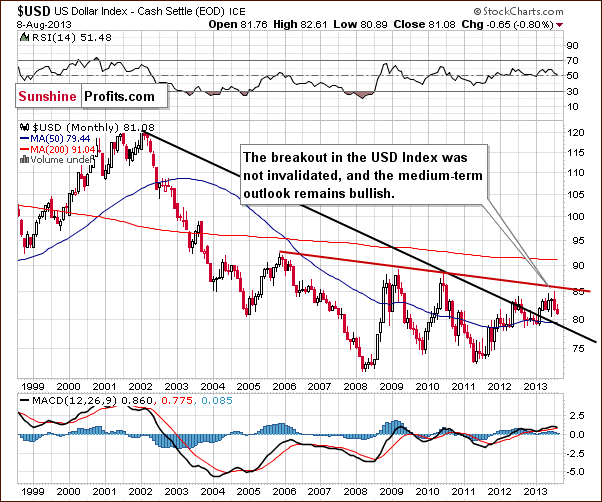
As we wrote in our essay on gold, stocks and the dollar on July 24, 2013:
The breakout above the declining support/resistance line (currently close to 79) was still not invalidated.
The above paragraph is up-to-date also today. From the long-term perspective, the situation remains bullish.
Now, let’s zoom in on our picture of the USD Index and see the medium-term chart.

On the above weekly chart, we can see that in the past week, the USD Index declined once again. The recent declines took the index to the medium-term support line (currently close to the 81 level). Keep in mind that this strong support line stopped the decline in June (it was not even reached) and encouraged buyers to act, which resulted in a sharp rally in the following days. Taking this into account, we might see a similar situation in the coming days.
From this perspective, the medium-term uptrend is not threatened, and the situation remains bullish. Therefore we can expect the dollar to strengthen further in the coming weeks.
To make the U.S. dollar perspective complete, let’s see how the situation in the US currency may translate into the precious metals market. Let’s take a look at the Correlation Matrix (namely: gold correlations and silver correlations).

Basically, there have been changes in the values of coefficients since we commented on them previously in our essay on gold, stocks and the dollar on July 24:
We have seen negative correlation between the metals and the USD Index(…). Taking the short-term, bullish outlook for the USD Index into account, the implications for gold, silver, and the mining stocks are clearly bearish at this time.
At this point we would like to add that even though the USD Index declined by almost a full index point this week, gold didn’t rally – it moved lower by about $3. Gold’s underperformance remains in place – or at least Thursday’s rally is not enough to change it.
Once we know the current situation in the U.S currency and its implications for the precious metals sector, let’s find out what happened during the recent days and check the current situation in gold from the perspective of the Australian dollar. Does it provide any important clues as to further gold’s price movements?
Click HERE or on image for larger version
On the gold priced in Australian dollar chart, we see that the previous breakout was invalidated very quickly, and the price came back below this declining resistance line. However, buyers didn’t give up and triggered one more move to the upside. That increase resulted in the next breakout above the previously-broken resistance/support line.
Despite this growth, gold did not manage to break above the June top as the above-mentioned strong resistance level stopped the rally. The corrective move took the yellow metal below the previously-broken resistance/support line and reached the 50-day moving average.
Keep in mind that we saw similar price action in June. After an invalidation of a breakout above the above-mentioned declining support/resistance line, there was a pullback to this resistance line. The buyers, however, didn’t manage to push gold above it, resulting in strong declines. This time, the gold bulls were stronger and pushed the price a bit higher, but it doesn’t change the similarity between these two situations (still looks like a double-top pattern).
In June, the strong corrective move took gold‘s price all the way back down to the April bottom area. If we see similar price action here, gold priced in Australian dollars will likely decline heavily once again.
So, from this point of view, the recent price increase hasn’t changed the current outlook, and the implications remain bearish.
To finish off, let’s have a glance at a chart that synthesizes the “non-USD” perspective, as it features gold‘s price relative to an index of foreign currencies.
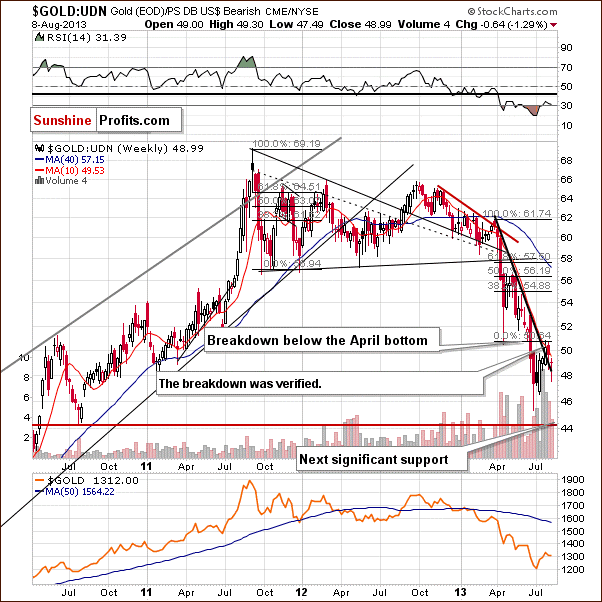
At the end of July we saw a move to the upside which took gold above the declining support/resistance level. However, the yellow metal didn’t manage to move back above the April bottom. This event brought negative consequences in the following days.
We clearly see that gold showed weakness in the past week as well as this one, and the breakdown below the April’s bottom was verified.
Gold has not broken below the declining support line so far. When it does, the decline will be likely to accelerate.
Summing up, the situation in gold remains bearish. Gold moved higher on Thursday, but overall it’s down $2.90 this week (taking Thursday’s closing price into account), while at the same time, the USD Index is down almost a full index point. Gold continues to underperform the dollar and a one-day rally on relatively low (compared to the size of the rally and volume accompanying previous days’ declines) volume doesn’t change that. The situation remains in tune with previous bearish price patterns.
Thank you for reading. Have a great and profitable week!
Przemyslaw Radomski, CFA
Founder, Editor-in-chief
Gold Investment & Silver Investment Website – SunshineProfits.com
* * * * *
Disclaimer
All essays, research and information found above represent analyses and opinions of Przemyslaw Radomski, CFA and Sunshine Profits’ associates only. As such, it may prove wrong and be a subject to change without notice. Opinions and analyses were based on data available to authors of respective essays at the time of writing. Although the information provided above is based on careful research and sources that are believed to be accurate, Przemyslaw Radomski, CFA and his associates do not guarantee the accuracy or thoroughness of the data or information reported. The opinions published above are neither an offer nor a recommendation to purchase or sell any securities. Mr. Radomski is not a Registered Securities Advisor. By reading Przemyslaw Radomski’s, CFA reports you fully agree that he will not be held responsible or liable for any decisions you make regarding any information provided in these reports. Investing, trading and speculation in any financial markets may involve high risk of loss. Przemyslaw Radomski, CFA, Sunshine Profits’ employees and affiliates as well as members of their families may have a short or long position in any securities, including those mentioned in any of the reports or essays, and may make additional purchases and/or sales of those securities without notice.

Second quarter GDP figures in Japan came in well below expectations. The Japanese economy grew 2.6% in Q2 at an annualized rate, below economists’ consensus prediction for 3.6% growth. Business spending fell 0.1% year over year in the second quarter, versus forecasts for a 0.6% rise.
Japan industrial production contracted 3.1% from the previous month in June and fell 4.6% year over year, versus a 3.3% and 4.8% contraction, respectively, in May. Capacity utilization fell 2.3% in June after rising 2.3% the month before.
The Yen hit $96.04 against $96.33 prior to the data print, MarketWatch’s Michael Kitchen says.
The Nikkei is also off -1.26%.
Seasonally-adjusted GDP climbed +0.6% against Q1’s +0.9%.
As we recently explained, Japanese economic data has been doing a lot of missing expectations lately. Industrial production, household spending and July PMI all fell short.
Plus, July employment fell for the first time in three months.
Abe-nomics — the loose monetary policy ordered by Prime Minister Shinzo Abe to reinflate Japan’s economy — have now been in place about half a year.

There was a nice move in both gold and silver overnight and the rally continued as the metals opened for the week in New York.
One trader explains the bullish move was brought on by backwardation in the futures market (when the spot market trades higher than the nearest futures price). This can be explained by a demand for physical gold or immediate delivery, and thus, as well explains higher wait times for manufactured product.
Click here to view a clip from Bloomberg TV.


The Half Full Economy
The marginal economic strength that was described in the most recent GDP release from Washington has caused many to double down on their belief that the Federal Reserve will begin tapering Quantitative Easing sometime later this year. While I believe that is a fantasy given our economy’s extreme dependence on QE, market observers should have learned long ago that the Bureau of Economic Analysis (BEA) initial GDP estimates can’t be trusted. A perusal of their subsequent GDP revisions in the last five years reveals a clear trend: They are almost twice as likely to revise initial estimates down rather than up, and the downward adjustments have been much larger on average.
As a result of this phenomenon, an overall optimism has pervaded the economic discussion that has consistently been unfulfilled by actual performance. The government is continuously over promising and under delivering. Unfortunately, no one seems to care.
Measuring the size of the economy accurately in anything close to real time is difficult, inexact, and messy. That is why the BEA has long pursued a policy of initial quarterly estimates (known as the “advanced estimate”), followed by two or three subsequent revisions as more thorough analysis comes to bear. The first estimates come out about a month after the conclusion of a particular quarter. The second and third revisions then come in monthly intervals thereafter. But in the minds of the media, the public and the politicians, the initial report carries much more weight than the revisions. It is the initial report that attracts the screaming headlines and sets the tone. The revisions are typically buried and ignored. This creates an unfortunate situation where the initial estimates are both the most important and the least reliable.
However, logic would dictate that revisions would fall equally in the up and down categories. After all, government bean counters are expected to report objectively, not to create a narrative or manage expectations. If anything, I believe that the public would be better served if they would adhere to the conservative playbook of under promising. That is exactly what they seemed to be doing before the economic crash of 2008. From 2002 to mid-summer 2008, the BEA revised initial GDP estimates a total of 25 times, 80% of which (20 revisions) were higher than their initial estimate. However, the average amplitude of the upward and downward revisions were equal at .5%. The difference may have been a function of the relatively strong economy that the nation saw over that time (which I believe was a result of the unsustainable and artificial housing boom). See the chart below.

But since mid-2008 we have seen a very different story. 67% of the revisions (12 of 18) have been downward, and those adjustments have been, on average, 50% larger than the upward revisions (.75% vs. .5%). Here’s another way of looking at it: Since mid-2008, revisions have shaved a total of 6 points of growth off the initial estimates. This works out to be an average of 1.3 points of growth per year that some may have expected but that never actually happened.
The pattern of early optimism may stem from the lack of understanding in Washington about how monetary stimulus actually retards economic growth. Many of the statisticians may be former academics who take it as gospel that government spending and money printing create growth. As a result, they expect the initial boost created by stimulus to be sustainable. The evidence suggests that it is not.
But there can be little doubt that these overly optimistic projections have worked wonders on the public relations front. The big Wall Street firms and the talking heads on financial TV set the tone by jumping on the new releases and ignoring the revisions to prior releases. That is precisely what happened last week when the better than expected 1.7% growth in 2nd quarter GDP overshadowed the .7% downward revision to 1st quarter GDP from 1.8% to 1.1%. The initial estimate for 1st quarter GDP, released back in April, was 2.5%. Since the consensus expectation for 2nd quarter GDP was just 1%, the media jumped all over the “good” news, while ignoring the revisions to the prior quarter, and discounting the strong likelihood that Q2 GDP will be revised downward. The nature of our short-term 24-hour news cycle is a big factor in this. Reporters are always looking for the big story of the day, not the minutia of last month. The lack of critical thinking and economic understanding also play a role.
Of course even if you have the discipline to focus on the final estimates, you still aren’t getting the real story. All GDP estimates are based on imperfect inflation measurement tools, which I believe are designed to under report inflation and over report growth. The most recent GDP projection used an annualized .71% inflation deflator to arrive at 1.7% growth. Anyone who believes that inflation is currently running below 1% has simply no grasp of our current economy. Look for more analysis of this topic in my upcoming columns. In the meantime, don’t get excited by initial reports of a healthy recovery. The reality is likely to be more sobering.
Peter Schiff is the CEO and Chief Global Strategist of Euro Pacific Capital, best-selling author and host of syndicated Peter Schiff Show.
Subscribe to Euro Pacific’s Weekly Digest: Receive all commentaries by Peter Schiff, John Browne, and other Euro Pacific commentators delivered to your inbox every Monday!
Don’t forget to sign up for our Global Investor Newsletter.



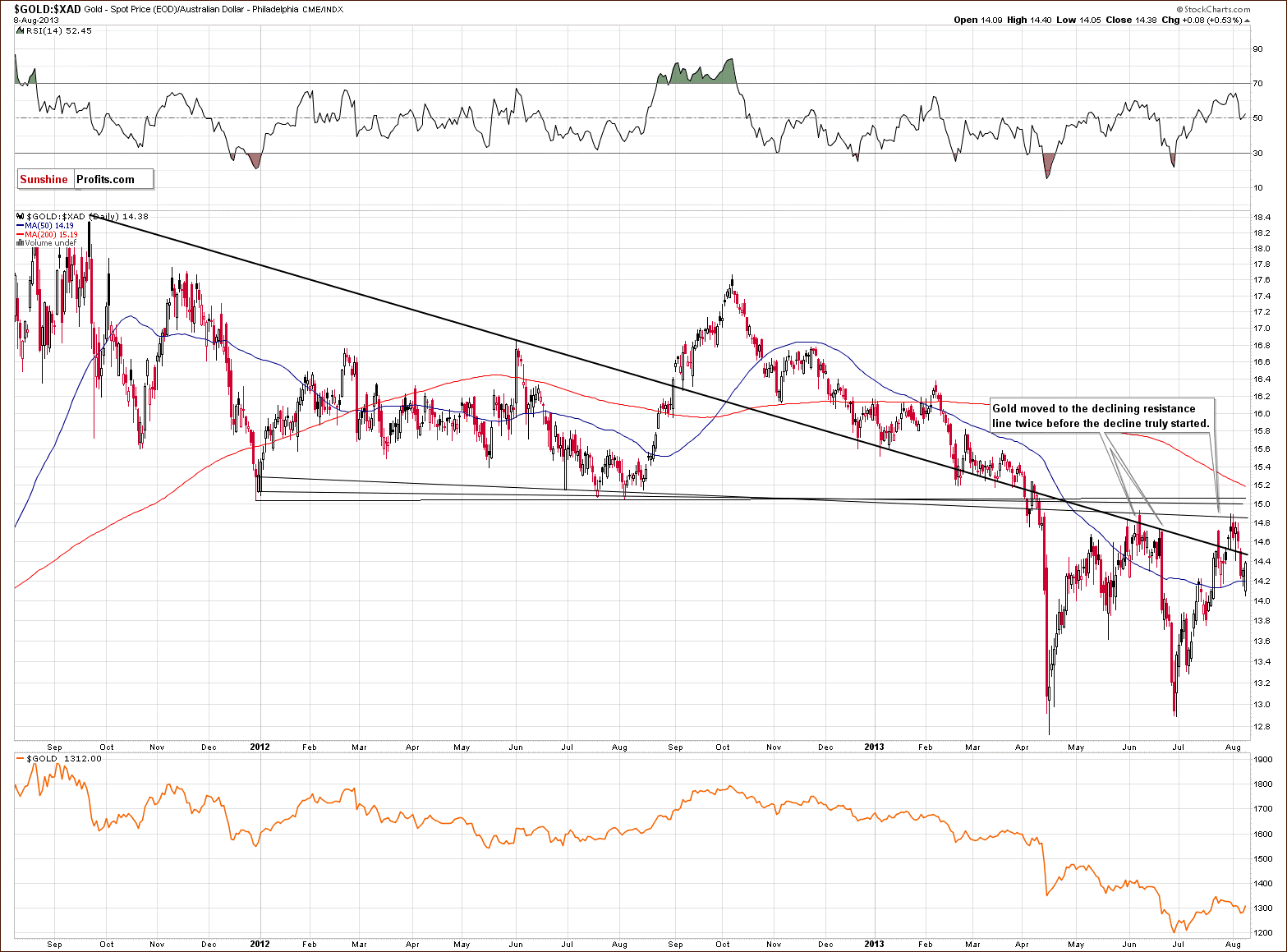
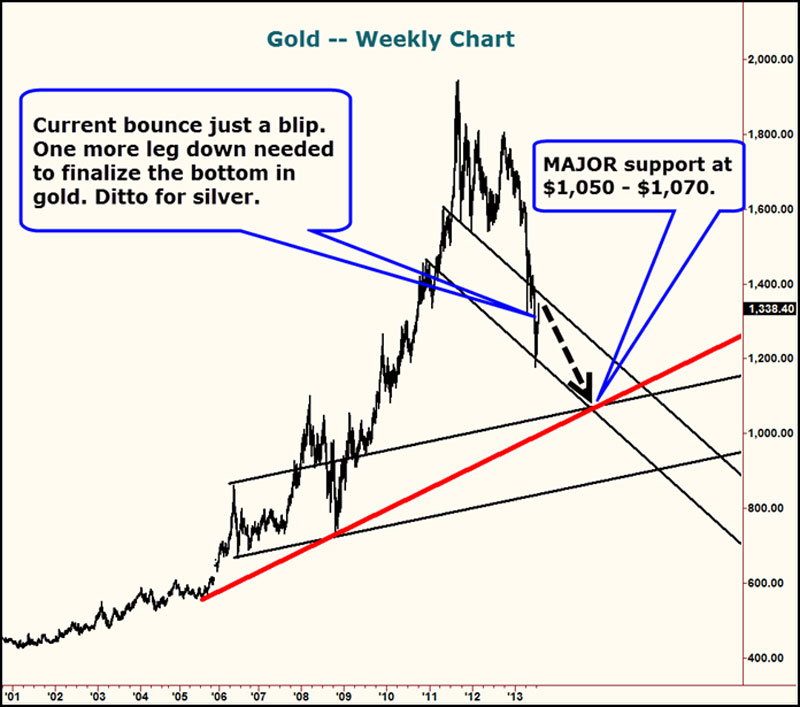
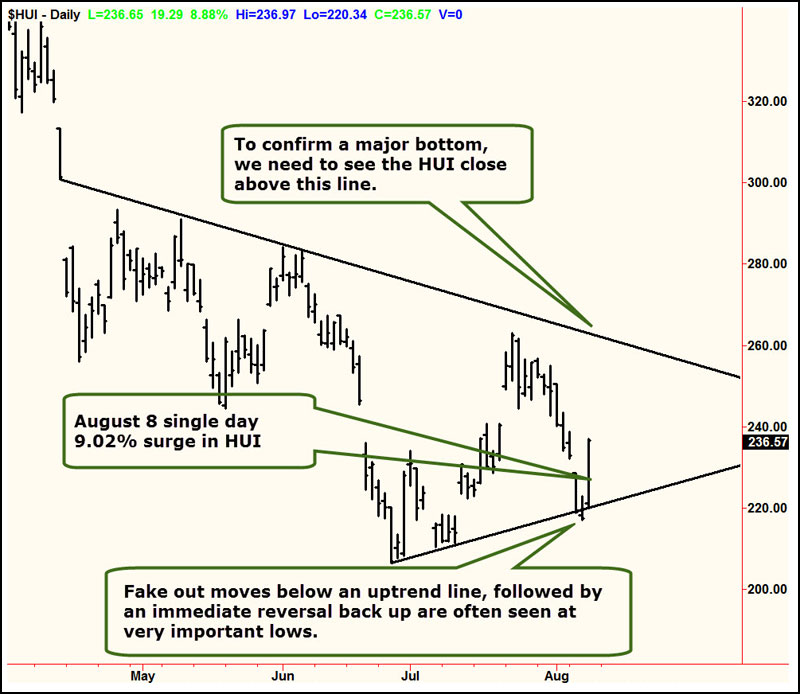
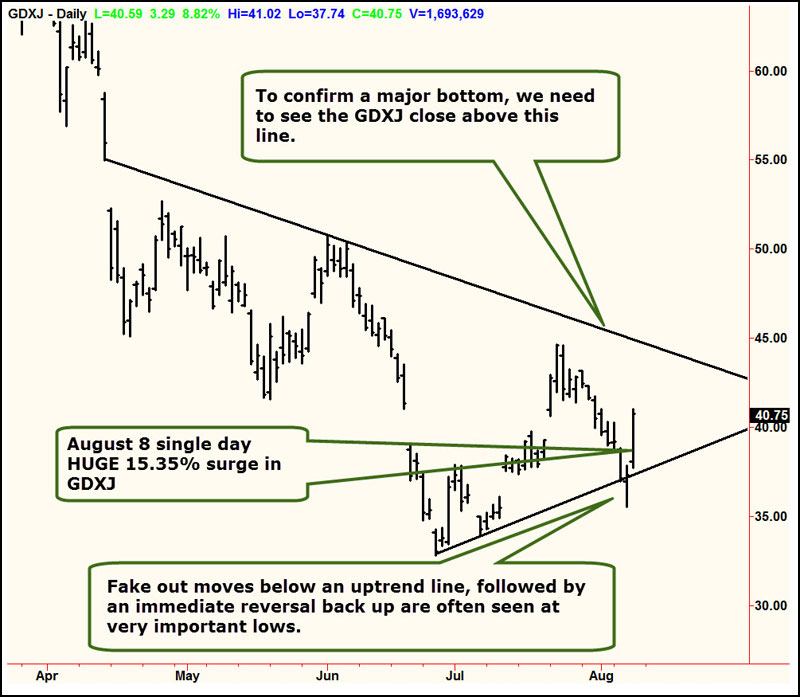
 As to the second question, my models do indeed still show the potential for gold and silver to slide going into September and test the prior major lows or even spike lower to new lows.
As to the second question, my models do indeed still show the potential for gold and silver to slide going into September and test the prior major lows or even spike lower to new lows.









